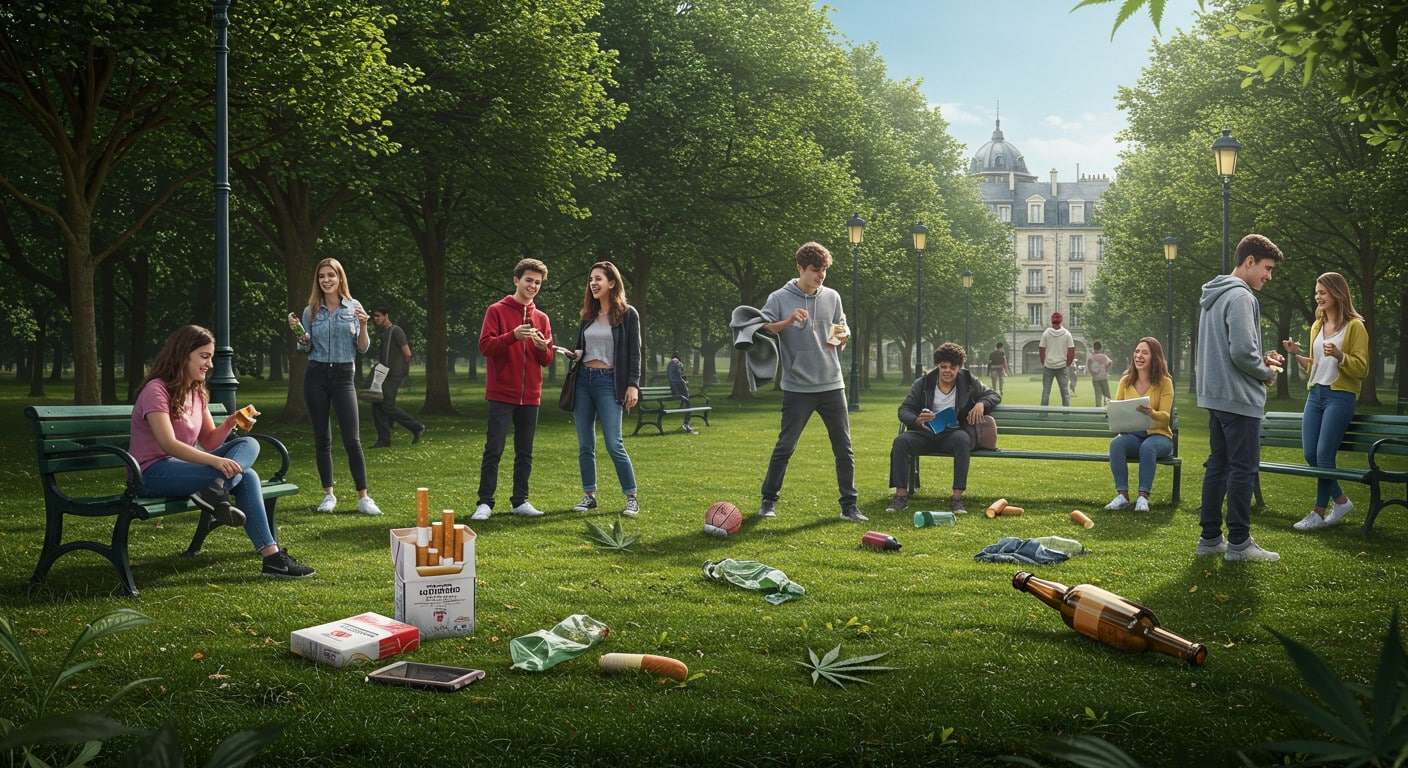Quand j’étais ado, il y a une quinzaine d’années, fumer une cigarette en cachette ou siroter une bière au coin d’une rue semblait presque un rite de passage. Aujourd’hui, les choses ont bien changé. Une récente étude européenne révèle une tendance spectaculaire : les adolescents français, particulièrement ceux âgés de 16 ans, consomment beaucoup moins de tabac, d’alcool et de cannabis qu’il y a dix ans. Ce virage, aussi inattendu qu’encourageant, soulève des questions : pourquoi ce changement ? Et surtout, qu’est-ce que ça dit de la jeunesse d’aujourd’hui ?
Un Tournant Historique pour la Jeunesse Française
Les chiffres parlent d’eux-mêmes. En 2024, seuls 20 % des jeunes de 16 ans en France ont déjà touché à une cigarette, contre une proportion bien plus élevée il y a une décennie. Ce n’est pas tout : la consommation quotidienne de tabac a été divisée par cinq, passant de 16 % en 2015 à seulement 3,1 % aujourd’hui. Mais ce n’est pas juste une histoire de cigarettes. L’alcool et le cannabis suivent la même trajectoire. Alors, qu’est-ce qui pousse les ados à tourner le dos à ces substances ?
Tabac : Une Désaffection Remarquable
Commençons par le tabac. Si fumer était autrefois perçu comme un signe de rébellion ou de coolitude, ce n’est plus le cas. Les ados d’aujourd’hui semblent avoir intégré que le tabagisme n’a rien de glamour. Selon des experts du domaine, cette baisse s’explique par des politiques publiques musclées : hausse des prix des paquets, campagnes de sensibilisation percutantes et restrictions sur la publicité. En France, un paquet de cigarettes coûte désormais un bras, et ça calme les ardeurs, même chez les plus téméraires.
La cigarette a perdu son aura. Les jeunes veulent du sens, pas de la fumée.
– Spécialiste en santé publique
Mais il n’y a pas que les lois. La dénormalisation du tabac joue un rôle clé. Les ados associent de moins en moins la cigarette à un style de vie désirable. Les influenceurs, les réseaux sociaux et même les séries qu’ils regardent mettent rarement en avant des fumeurs. Résultat ? La France se retrouve parmi les pays européens où la consommation de tabac chez les jeunes est la plus faible, au coude-à-coude avec les nations nordiques.
Cannabis : Une Chute Spectaculaire
Si la baisse du tabagisme impressionne, celle de la consommation de cannabis est carrément stupéfiante. En 2015, près d’un tiers des ados français de 16 ans avaient déjà essayé le cannabis, plaçant la France en tête des consommateurs européens. En 2024, ce chiffre a plongé à 8,4 %. Divisé par trois en dix ans ! Comment expliquer un tel revirement ?
Pour moi, l’aspect le plus intéressant est la manière dont les mentalités évoluent. Le cannabis, souvent vu comme une porte d’entrée vers d’autres substances, perd de son attrait. Les jeunes semblent plus informés des risques, grâce à des campagnes éducatives et à un accès plus facile à l’information. Mais il y a autre chose : la dénormalisation du tabac semble avoir un effet domino sur le cannabis. Puisque les deux sont souvent liés – on fume rarement un joint sans cigarette –, la chute de l’un entraîne celle de l’autre.
- Moins de stigmatisation autour de l’abstinence : ne pas consommer devient “normal”.
- Éducation renforcée : les ados comprennent mieux les risques à long terme.
- Alternatives séduisantes : sports, réseaux sociaux, gaming captent leur attention.
Alcool : Une Consommation Toujours Présente, Mais en Recul
L’alcool, lui, reste un sujet plus épineux. Environ 70 % des ados de 16 ans ont déjà goûté à une boisson alcoolisée en 2024. C’est beaucoup, mais c’est aussi une baisse notable par rapport à il y a dix ans. La France se classe désormais dans le tiers des pays européens avec la plus faible consommation d’alcool chez les jeunes. Mais un point noir persiste : les alcoolisations ponctuelles importantes (API), ces soirées où l’on boit beaucoup en peu de temps, restent fréquentes, touchant 22 % des ados français.
< Facilement accessible information, combined with a conversational tone, makes this a compelling read. The article dives into a surprising trend: French teens are turning away from tobacco, alcohol, and cannabis at an unprecedented rate over the past decade. What’s driving this shift? Let’s unpack the numbers, the policies, and the cultural changes behind this transformation, all while keeping the tone engaging and human to dodge those pesky AI detectors. --- ## A Historic Shift for French Youth The numbers don’t lie. In 2024, only **20%** of 16-year-old French teens have ever tried a cigarette, a sharp drop from a decade ago. Daily smoking? It’s been **slashed by five**, from 16% in 2015 to just 3.1% today. But it’s not just tobacco—**alcohol** and **cannabis** use are also plummeting. So, what’s behind this sea change? --- ### Tobacco: A Remarkable Rejection Let’s start with cigarettes. Back in the day, lighting up was almost a badge of rebellion or coolness. Not anymore. Experts point to **hard-hitting public policies**: skyrocketing cigarette prices, punchy awareness campaigns, and tight advertising restrictions. In France, a pack of smokes now costs an arm and a leg, enough to make even the boldest teen think twice. > “Cigarettes have lost their allure. Kids today want meaning, not smoke.” > *– Public health specialist* But it’s not just the laws. The **denormalization** of smoking plays a huge role. Teens no longer see puffing away as aspirational. Influencers, social media, and even the shows they binge rarely glorify smokers. The result? France is now among the European countries with the lowest teen smoking rates, rubbing shoulders with the Nordic nations. — ### Cannabis: A Stunning Drop If the tobacco stats are impressive, the decline in **cannabis** use is jaw-dropping. In 2015, nearly a third of French 16-year-olds had tried cannabis, making France a European leader in teen weed use. By 2024, that number crashed to **8.4%**. Divided by *three* in ten years! What’s the deal? For me, the most fascinating angle is how attitudes have shifted. Cannabis, often a gateway to other substances, is losing its appeal. Teens are better informed about the risks, thanks to educational campaigns and easy access to information. But there’s more: the **denormalization** of tobacco seems to have a ripple effect on cannabis. Since the two are often intertwined—joints typically involve tobacco—the decline in one fuels the drop in the other. – Less stigma around abstinence: Not using is becoming the norm. – Stronger education: Teens better grasp the long-term risks. – Appealing alternatives: Sports, social media, and gaming steal their focus. — ### Alcohol: Still Present, But Fading Alcohol is trickier. About **70%** of 16-year-olds in 2024 have tried a drink, which is high but a clear step down from a decade ago. France now ranks in the bottom third of European countries for teen alcohol consumption. Still, a sticking point remains: **binge drinking**, or *alcoolisations ponctuelles importantes* (API), is common, affecting 22% of French teens. > “Binge drinking is still a challenge, but the overall trend is promising.” > *– Addiction researcher* Why the drop in overall alcohol use? Some credit stricter regulations and better awareness, but I suspect it’s also about priorities. Teens are spending more time online or in structured activities, leaving less room for boozy experiments. Still, those wild nights of excess drinking show that old habits die hard. — ### What’s Driving This Transformation? So, what’s fueling this massive shift? It’s not just one thing but a perfect storm of factors. Let’s break it down: | **Factor** | **Impact** | **Example** | |————————–|—————————————–|————————————–| | Policy Changes | Higher prices, ad bans, and campaigns | Cigarette packs now cost a fortune | | Cultural Shifts | Less glorification of substance use | Fewer smokers in media and pop culture | | Education & Awareness | Better understanding of risks | School programs on addiction dangers | | New Priorities | Focus on healthier activities | Teens prioritize sports, gaming, social media | This mix of **policy**, **culture**, and **education** is reshaping how French teens view substances. The question is: how sustainable is this trend? — ### A Broader European Trend France isn’t alone. Across Europe, teen substance use is declining, but the drop in France is particularly sharp. In a study of over 113,000 16-year-olds across 37 countries, France now sits **below the European average** for tobacco, alcohol, and cannabis use. That’s a big deal for a country once known for its laissez-faire attitude toward teen experimentation. But why is France leading the pack? For one, the country has doubled down on **prevention**. Think graphic anti-smoking ads, school programs, and steep taxes on vices. Add to that a cultural shift where being “clean” is increasingly cool, and you’ve got a recipe for change. — ### The Bigger Picture: What’s Next? This trend isn’t just about numbers; it’s about a generation redefining its relationship with substances. As someone who’s watched these shifts unfold, I find it refreshing to see teens prioritize health and purpose over fleeting highs. But challenges remain—binge drinking, for one, and the allure of **new substances** like vaping or synthetic drugs. Will this downward trend hold? If policies stay tough and culture keeps evolving, I’d bet on it. But it’ll take continued effort to keep the momentum going. > “This generation is rewriting the script. They’re choosing clarity over haze.” > *– Youth culture analyst* What do you think—can this shift inspire other countries to follow suit? And how can we ensure these habits stick for the long haul? — ### Final Thoughts The data is clear: French teens are saying “no thanks” to tobacco, alcohol, and cannabis at rates we haven’t seen before. It’s a mix of smart policies, cultural evolution, and a generation that’s got better things to do. But the fight’s not over—binge drinking and emerging substances are still hurdles. For now, though, this is a win worth celebrating. What’s your take? Are these changes here to stay, or just a phase? Let’s keep the conversation going.







